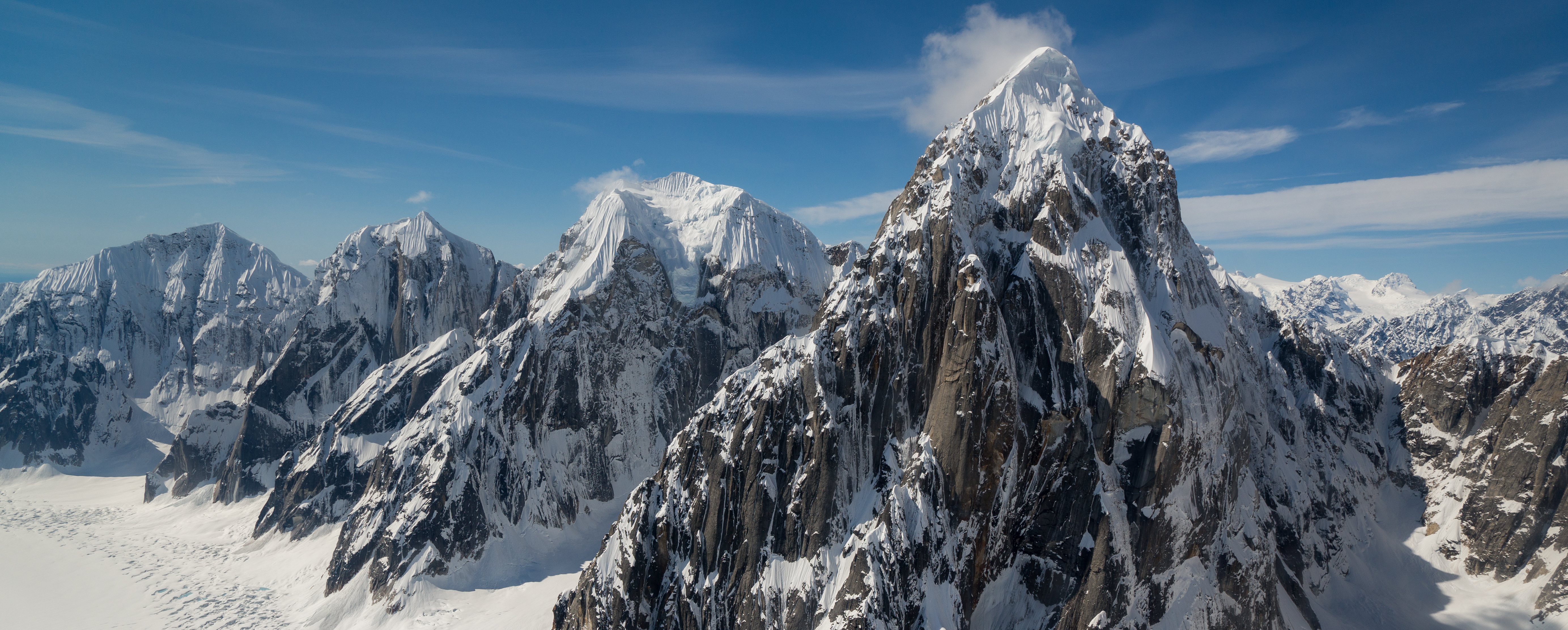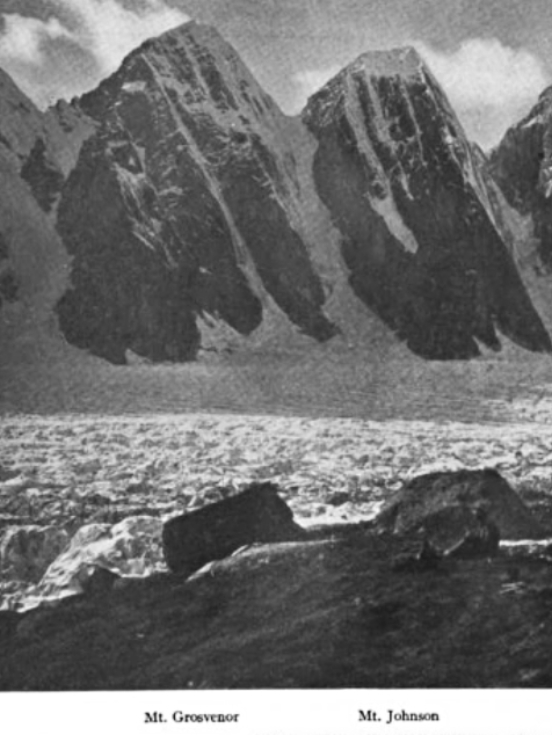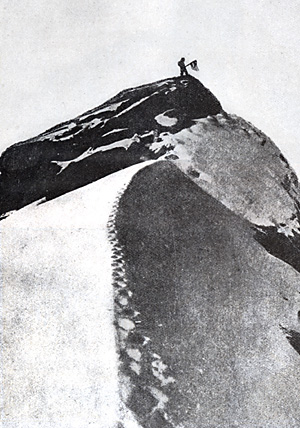|
Ruth Glacier
Ruth Glacier is a glacier in Denali National Park and Preserve in the U.S. state of Alaska. Its upper reaches are approximately 3 vertical miles below the summit of Denali. The glacier's "Great Gorge" is one mile wide, and drops almost 2,000 feet over 10 miles, with crevasses along the surface. Above the surface on both sides are 4,900-foot granite cliffs. From the top of the cliffs to the bottom of the glacier is a height exceeding that of the Grand Canyon. Ruth Glacier moves at a rate of three feet per day and was measured to be 4,000 feet thick in 1983. Surrounding the Ruth Gorge are many mountains of the Alaska Range, including the Mooses Tooth, Mount Dickey, Mount Bradley, Mount Wake, Mount Johnson, and London Tower with highly technical ice and rock climbs on their faces. History In 1903, the glacier was explored by physician and ethnographer Frederick Cook, who named it after his youngest daughter. See also * List of glaciers * Fake Peak Fake Peak is a small outcrop on ... [...More Info...] [...Related Items...] OR: [Wikipedia] [Google] [Baidu] |
Matanuska-Susitna Borough, Alaska
Matanuska-Susitna Borough (often referred to as the Mat-Su Borough) is a borough located in the U.S. state of Alaska. Its county seat is Palmer, and the largest community is the census-designated place of Knik-Fairview. The borough is part of the Anchorage Metropolitan Statistical Area, along with the municipality of Anchorage on its south. The Mat-Su Borough is so designated because it contains the entire Matanuska and Susitna Rivers. They empty into Cook Inlet, which is the southern border of the Mat-Su Borough. It is one of the few agricultural areas of Alaska. Geography The borough seat is Palmer, and the largest community is the census-designated place of Knik-Fairview, Alaska. As of the 2020 census, the population was 107,081, up from 88,995 in 2010. It is the fastest growing subdivision in Alaska. According to the U.S. Census Bureau, the borough has a total area of , of which is land and (2.6%) is water. Adjacent boroughs and census areas * Denali Borough, ... [...More Info...] [...Related Items...] OR: [Wikipedia] [Google] [Baidu] |
Mount Johnson (Alaska)
Mount Johnson is an mountain summit located in the Alaska Range, in Denali National Park and Preserve, in Alaska, United States. It is situated on the west side of the Ruth Gorge, southeast of Denali and south-southwest of The Moose's Tooth. Its nearest higher peak is Mount Wake, to the northwest. Despite its relatively low elevation, it is notable for its north face with over 4,000 feet of vertical sheer granite with climbing routes called the ''Escalator'' and ''Stairway to Heaven''. The first ascent of the peak was made in 1979 by Gary Bocarde, Charlie Head, John Lee, and Jon Thomas via the south ridge. The mountain was named by famed explorer Dr. Frederick Cook who claimed the first ascent of Mount McKinley in 1906, but was later disproved. Climate Based on the Köppen climate classification, Mount Johnson is located in an alpine climate zone with long, cold, snowy winters, and cool summers. Temperatures can drop below −20 °C with wind chill factors below −30 ... [...More Info...] [...Related Items...] OR: [Wikipedia] [Google] [Baidu] |
Glaciers Of Matanuska-Susitna Borough, Alaska
A glacier (; ) is a persistent body of dense ice that is constantly moving under its own weight. A glacier forms where the accumulation of snow exceeds its ablation over many years, often centuries. It acquires distinguishing features, such as crevasses and seracs, as it slowly flows and deforms under stresses induced by its weight. As it moves, it abrades rock and debris from its substrate to create landforms such as cirques, moraines, or fjords. Although a glacier may flow into a body of water, it forms only on land and is distinct from the much thinner sea ice and lake ice that form on the surface of bodies of water. On Earth, 99% of glacial ice is contained within vast ice sheets (also known as "continental glaciers") in the polar regions, but glaciers may be found in mountain ranges on every continent other than the Australian mainland, including Oceania's high-latitude oceanic island countries such as New Zealand. Between latitudes 35°N and 35°S, glaciers occur only in ... [...More Info...] [...Related Items...] OR: [Wikipedia] [Google] [Baidu] |
Mount Barrille
Mount Barrille is a mountain summit located in the Alaska Range, in Denali National Park and Preserve, in the U.S. state of Alaska. It is situated 2,650 feet above the Ruth Glacier at the gateway to the Don Sheldon Amphitheater, or The Great Gorge, depending on direction of travel. Barrille is set southeast of Denali, west of The Mooses Tooth, east of The Rooster Comb, and north of Mount Dickey which is its nearest higher peak. The mountain was named by famed explorer Dr. Frederick Cook for Edward Barrill (1861-1946), a horse packer from Darby, Montana, who was his sole companion during his 1906 claim to be the first to climb Mount McKinley. The claim was later disproved, and in 1909 Barrill signed an affidavit stating that they had not reached the summit. Cook referred to his companion as ''Barrille'' in his accounts of the expedition, and Barrille remains as the official spelling used by the United States Geological Survey. Climbing Despite its relatively low elevation, M ... [...More Info...] [...Related Items...] OR: [Wikipedia] [Google] [Baidu] |
Mount Grosvenor (Alaska Range)
Mount Grosvenor is an mountain summit located in the Alaska Range, in Denali National Park and Preserve, in Alaska, United States. It is situated on the west side of the Ruth Gorge, northwest of Mount Church and south of Mt. Johnson. Its nearest higher peak is Mount Wake, to the northwest. Despite its relatively low elevation, it is notable for its east face with over 4,000 feet of vertical sheer granite. The mountain was named by famed explorer Dr. Frederick Cook who claimed the first ascent of Mount McKinley in 1906, but was later disproved. This peak's unofficial name honors Gilbert Hovey Grosvenor (1875–1966), President of the National Geographic Society, father of photojournalism, and the first full-time editor of ''National Geographic'' magazine. The first ascent of the peak was made in 1979 by Gary Bocarde, Charlie Head, John Lee, and Jon Thomas.''Appalachia'', Summer/Fall 2005, Volumes 56-58, page 111 Climate Based on the Köppen climate classification, Mount Gro ... [...More Info...] [...Related Items...] OR: [Wikipedia] [Google] [Baidu] |
Mount Church (Alaska)
Mount Church is a mountain in the Alaska Range, in Denali National Park and Preserve, overlooking Ruth Glacier. It is situated on the west side of the Ruth Gorge and southeast of Mount Grosvenor, which is the nearest higher neighbor. The mountain was named by famed explorer Dr. Frederick Cook who claimed the first ascent of Mount McKinley in 1906, but was later disproved. Climate Based on the Köppen climate classification, Mount Church is located in a subarctic climate zone with long, cold, snowy winters, and cool summers. Temperatures can drop below −20 °C with wind chill factors below −30 °C. The months May through June offer the most favorable weather for climbing or viewing. See also *Mountain peaks of Alaska This article comprises three sortable tables of major mountain peaksThis article defines a significant summit as a summit with at least of topographic prominence, and a major summit as a susexxleast of topographic prominence. All summits i . ... [...More Info...] [...Related Items...] OR: [Wikipedia] [Google] [Baidu] |
The Mooses Tooth
The Moose's Tooth (or simply Moose's Tooth, Mooses Tooth) is a rock peak on the east side of the Ruth Gorge in the Central Alaska Range, 15 miles (24 km) southeast of Denali. Despite its relatively low elevation, it is a difficult climb. It is notable for its many large rock faces and its long ice couloirs, which are famous in mountaineering circles, and have seen a number of highly technical ascents. The peak was originally called Mount Hubbard after General Thomas Hamlin Hubbard — the president of the Peary Arctic Club — by Belmore Browne and Herschel Parker. This name was revoked by the United States Geological Survey, which named the peak "The Mooses Tooth," a translation of the Athabascan name for the peak.That "Moose's Tooth" is a native name for the peak is attested by Bradford Washburn in "Mapping McKinley's Southeast Approaches", ''American Alpine Journal'', 1956, p. 49. The official USGS name does lack the grammatically correct apostrophe. The Moose' ... [...More Info...] [...Related Items...] OR: [Wikipedia] [Google] [Baidu] |
Fake Peak
Fake Peak is a small outcrop on a ridge beside the Ruth Glacier in Denali National Park and Preserve in Alaska, US, 19 miles southeast of the summit of Denali. It has been shown by Robert M. Bryce that the "summit photograph" produced by Frederick Cook Frederick Albert Cook (June 10, 1865 – August 5, 1940) was an American explorer, physician, and ethnographer who claimed to have reached the North Pole on April 21, 1908. That was nearly a year before Robert Peary, who similarly claime ... as evidence supporting his claim to have made the first ascent of Denali was taken on Fake Peak.Robert M. Bryce"Dr. Cook – Mt. McKinley Controversy Closed" ''DIO'', Vol. 7, Nos. 2–3, December 1997, At , this is almost lower than the true summit of Denali. References Mountains of Matanuska-Susitna Borough, Alaska Mountains of Alaska Climbing areas of Alaska {{MatanuskaSusitnaAK-geo-stub ... [...More Info...] [...Related Items...] OR: [Wikipedia] [Google] [Baidu] |
List Of Glaciers
A glacier ( ) or () is a persistent body of dense ice that is constantly moving under its own weight; it forms where the accumulation of snow exceeds its ablation (melting and sublimation) over many years, often centuries. Glaciers slowly deform and flow due to stresses induced by their weight, creating crevasses, seracs, and other distinguishing features. Because glacial mass is affected by long-term climate changes, e.g., precipitation, mean temperature, and cloud cover, glacial mass changes are considered among the most sensitive indicators of climate change. There are about 198,000 to 200,000 glaciers in the world. Glaciers by continent Africa Africa, specifically East Africa, has contained glacial regions, possibly as far back as the last glacier maximum 10 to 15 thousand years ago. Seasonal snow does exist on the highest peaks of East Africa as well as in the Drakensberg Range of South Africa, the Stormberg Mountains, and the Atlas Mountains in Morocco. Currently, ... [...More Info...] [...Related Items...] OR: [Wikipedia] [Google] [Baidu] |
Frederick Cook
Frederick Albert Cook (June 10, 1865 – August 5, 1940) was an American explorer, physician, and ethnographer who claimed to have reached the North Pole on April 21, 1908. That was nearly a year before Robert Peary, who similarly claimed to have reached the North Pole on April 6, 1909. Both men's accounts have been disputed ever since. His expedition was the first, and the only one with a United States national, to find a previously unknown, to people of European descent, North American Arctic island, Meighen Island. In December 1909, after reviewing Cook's limited records, a commission of the University of Copenhagen ruled his claim unproven. In 1911, Cook published a memoir of his expedition that continued his claim. His account of reaching the summit of Denali (Mount McKinley) in Alaska has also been discredited. Biography Cook was born in Hortonville, New York, in Sullivan County. (His birthplace is sometimes listed as Callicoon or Delaware, both also in Sullivan ... [...More Info...] [...Related Items...] OR: [Wikipedia] [Google] [Baidu] |
Climbing
Climbing is the activity of using one's hands, feet, or any other part of the body to ascend a steep topographical object that can range from the world's tallest mountains (e.g. the eight thousanders), to small boulders. Climbing is done for locomotion, sporting recreation, and for competition, and is also done in trades that rely on ascension; such as emergency rescue and military operations. Climbing is done indoors and outdoors and on natural (e.g. rock and ice) and artificial surfaces. Professional mountain guides or rock climbing guides (e.g. the UIAGM), were a significant element in developing the popularity of the sport in the natural environment, and remain so today. Since the 1980s, the development of competition climbing and the availability of artificial climbing walls have dramatically increased the popularity of rock climbing as a sport and led to the emergence of professional rock climbers, such as Wolfgang Güllich, Chris Sharma, Lynn Hill and Catherine ... [...More Info...] [...Related Items...] OR: [Wikipedia] [Google] [Baidu] |





